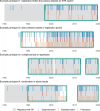Curating a longitudinal research resource using linked primary care EHR data-a UK Biobank case study
- PMID: 34897458
- PMCID: PMC8800530
- DOI: 10.1093/jamia/ocab260
Curating a longitudinal research resource using linked primary care EHR data-a UK Biobank case study
Abstract
Primary care EHR data are often of clinical importance to cohort studies however they require careful handling. Challenges include determining the periods during which EHR data were collected. Participants are typically censored when they deregister from a medical practice, however, cohort studies wish to follow participants longitudinally including those that change practice. Using UK Biobank as an exemplar, we developed methodology to infer continuous periods of data collection and maximize follow-up in longitudinal studies. This resulted in longer follow-up for around 40% of participants with multiple registration records (mean increase of 3.8 years from the first study visit). The approach did not sacrifice phenotyping accuracy when comparing agreement between self-reported and EHR data. A diabetes mellitus case study illustrates how the algorithm supports longitudinal study design and provides further validation. We use UK Biobank data, however, the tools provided can be used for other conditions and studies with minimal alteration.
Keywords: diabetes mellitus; electronic health records; longitudinal studies; medical record linkage; phenotype.
© The Author(s) 2021. Published by Oxford University Press on behalf of the American Medical Informatics Association.
Figures




